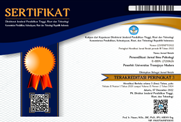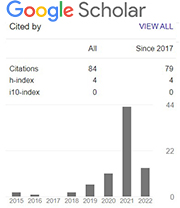Mengelola Keseimbangan Karir dan Pendidikan: Studi Fenomenologi Ibu yang Bekerja Sambil Kuliah S3 di Universitas Gadjah Mada
Abstract
Keywords
Full Text:
PDF (Bahasa Indonesia)References
Akinrole, O. O., & Ojo, O. D. (2020). Work-life balance: the relevance of social support. Academy of Straregic Management Journal, 19(3).
American Behavioral Clinics, -. (2022). What’s the difference between mental health and wellbeing?
Asbari, M., Bernarto, I., Pramono, R., Purwanto, A., Hidayat, D., Sopa, A., Alamsyah, V. U., Senjaya, P., Fayzhall, M., & M. (2020). The effect of work-family conflict on job satisfaction and performance: A study of Indonesian female employees. International Journal of Advanced Science and Technology, 29(3), 6724–2748.
Asri, A., Ansar, A., & Munir, A. R. (2019). Pengaruh kompensasi, fasilitas kerja dan kepemimpinan terhadap kinerja melalui kepuasan kerja pegawai pada rektorat UIN alauddin makassar. YUME: Journal of Management, 2(1), 1–10.
Azhar, M. E., Nurdin, D.U., & Siswadi, Y. (2020). Pengaruh disiplin kerja dan kompensasi terhadap kepuasan kerja karyawan. Jurnal Humaniora: Jurnal Ilmu Sosial, Ekonomi Dan Hukum, 4(1), 46–60. https://doi.org/10.30601/humaniora.v4i1.422
Baker, E., Avery, G. C., & Crawford, J. (2007). Satisfaction and perceived productivity when professionals work from home. Research and Practice in Human Resource Management, 15(1), 37–62.
Boakye, A. N., Asravor, R. K., & Essuman, J. (2022). Work-life balance as predictors of job satisfaction in the tertiary educational sector. Cogent Business & Management, 10(1). https://doi.org/10.1080/23311975.2022.2162686
CFI Team, -. (n.d.). The Art of Time Management for Better Work-Life Balance.
Chan, X. W., Kalliath, T., Brough, P., Siu, O.-L., O’Driscoll, M. P., & Timms, C. (2016). Work–family enrichment and satisfaction: the mediating role of self-efficacy and work–life balance. The International Journal of Human Resource Management, 27(15), 1755–1776. https://doi.org/10.1080/09585192.2015.1075574
Creswell, J. W. (2013). Qualitative inquiry and research design (3rd ed). CA: Sage.
Delve, H. L., & Limpaecher, A. (2022). What is phenomenological research design? essential guide to coding qualitative data.
Education ACo. (2020). Mental health task forces in higher education.
Eisenkopf, G. (2018). The long-run effects of communication as a conflict resolution mechanism. Journal of Economic Behavior & Organization, 154, 121–136. https://doi.org/10.1016/j.jebo.2018.08.002
Evans, P., & Bartolomé, F. (1984). The changing pictures of the relationship between career and family. Journal of Organizational Behavior, 5(1), 9–21. https://doi.org/10.1002/job.4030050103
Fisher, G. G., Bulger, C. A., & Smith, C. S. (2009). Beyond work and family: a measure of work/nonwork interference and enhancement. Journal of Occupational Health Psychology, 441–456. https://doi.org/10.1037/a0016737
Forson, C. (2013). Contextualizing migrant black business women’s work-life balance experiences. International Journal of Entrepreneurship Behaviour & Research, 19(5), 460–477. https://doi.org/10.1108/IJEBR-09-2011-0126
Gragnano, A., Simbula, S., & Miglioretti, M. (2020). Work-Life Balance: Weighting the Importance of work-family and work-health balance. International Journal of Environmental Research and Public Health, 17(3), 907. https://doi.org/10.3390/ijerph17030907
Grawitch, M. J., Maloney, P. W., Barber, L. K., & Mooshegian, S. E. (2013). Examining the nomological network of satisfaction with work–life balance. Journal of Occupational Health Psychology, 18(3), 276–284. https://doi.org/10.1037/a0032754
Guest, D. E. (2002). Perspectives on the Study of Work-life Balance. Social Science Information, 41(2), 255–279. https://doi.org/10.1177/0539018402041002005
Guy-Evans, O. (2023). Bronfenbrenner’s Ecological Systems Theory.
Hasbiansyah, O. (2008). Pendekatan fenomenologi: pengantar praktik penelitian dalam ilmu sosial dan komunikasi. Mediator: Jurnal Komunikasi, 9(1), 163–180. https://doi.org/10.29313/mediator.v9i1.1146
Huth, M. (2016). Segmentors vs integrators: google’s work-life balance research.
Kanti, T., & Seshadri, V. (2019). The impact of emotional intelligence in managing work-life balance in the it industry. 6(1).
Kumar, K., & Chaturvedi, R. (2018). An empirical study of social support, stress and life satisfaction among engineering graduates: mediating role of perceived work/study life balance. International Journal of Happiness and Development, 4(1), 25. https://doi.org/10.1504/IJHD.2018.090489
Laudel, G., & Gläser, J. (2008). From apprentice to colleague: The metamorphosis of Early Career Researchers. Higher Education, 55(3), 387–406. https://doi.org/10.1007/s10734-007-9063-7
Levecque, K., Anseel, F., De Beuckelaer, A., Van der Heyden, J., & Gisle, L. (2017). Work organization and mental health problems in PhD students. Research Policy, 46(4), 868–879. https://doi.org/10.1016/j.respol.2017.02.008
Liu, H.-L., & Lo, V. (2018). An integrated model of workload, autonomy, burnout, job satisfaction, and turnover intention among Taiwanese reporters. Asian Journal of Communication, 28(2), 153–169. https://doi.org/10.1080/01292986.2017.1382544
Liu, P., Wang, X., Li, A., & Zhou, L. (2019). Predicting Work–Family Balance: A New Perspective on Person–Environment Fit. Frontiers in Psychology, 10. https://doi.org/10.3389/fpsyg.2019.01804
Mays, T. L., & Smith, B. T. (2009). Navigating the Doctoral Journey. Journal of Hospital Librarianship, 9(4), 345–361. https://doi.org/10.1080/15323260903250411
Mendis, M. D. V. S., & Weerakkody, W. A. S. (2018). The impact of work life balance on employee performance with reference to telecommunication industry in Sri Lanka: a mediation model. Kelaniya Journal of Human Resource Management, 12(1), 72. https://doi.org/10.4038/kjhrm.v12i1.42
Nurkarimah, A., & Rositawati, S. (2023). Pengaruh Work Life Balance terhadap Turnover Intention pada Karyawan Milenial Perusahaan Startup Digital Kota Bandung. Bandung Conference Series: Psychology Science, 3(2), 705–712. https://doi.org/10.29313/bcsps.v3i2.7314
Pathak, V., Jena, B., & Kalra, S. (2013). Qualitative research. Perspectives in Clinical Research, 4(3), 192. https://doi.org/10.4103/2229-3485.115389
Perry, E. (2022). Self-care and work-life balance: How to take care of yourself.
Pope C., & M. N. (1996). Qualitative Methods in Health and Health Services Research. London: Qualitative Research in Health Care.
Rincy, V. M., & Panchanatham, N. (2014). Work Life Balance: a Short Review of the Theoretical and Contemporary Concepts. Continental J. Social Sciences, 7(1), 1–24. https://doi.org/10.5707/cjsocsci.2014.7.1.1.24
Robertson-Schule, L. L. (2014). An Investigation of The Relationships Between Emotional Intelligence, Engagement, And Performance. Capella University.
Rood, A. S., & Holdnak, A. (2013). An Analysis of Compensation Patterns and Job Satisfaction Issues of Resort Recreation Professionals. Journal of Tourism Insights, 4(1). https://doi.org/10.9707/2328-0824.1038
Thilagavathy., S. & Geetha., S.N. (2023). Work-life balance -a systematic review. Vilakshan - XIMB Journal of Management, 20(2), 258–276. https://doi.org/10.1108/XJM-10-2020-0186
Sampoerna, U. (2022). Hustle Culture: Definition, Impact, and How to Overcome It.
Schmidt, M., & Umans, T. (2014). Experiences of well-being among female doctoral students in Sweden. International Journal of Qualitative Studies on Health and Well-Being, 9(1), 23059. https://doi.org/10.3402/qhw.v9.23059
Scottl, K. S., Moore, K. S., & Miceli, M. P. (1997). An Exploration of the Meaning and Consequences of Workaholism. Human Relations, 50(3), 287–314. https://doi.org/10.1177/001872679705000304
Shylaja, P., & Prasad, D. C. J. (2017). Emotional Intelligence and Work Life Balance. IOSR Journal of Business and Management, 19(05), 18–21. https://doi.org/10.9790/487X-1905051821
Siedlecki, K. L., Salthouse, T. A., Oishi, S., & Jeswani, S. (2014). The Relationship Between Social Support and Subjective Well-Being Across Age. Social Indicators Research, 117(2), 561–576. https://doi.org/10.1007/s11205-013-0361-4
Spiegelberg, H., & Biemel, W. (2022). Phenomenology. In Encyclopedia Britannica.
Stephens, R., & Grzywacz, J. G. (2014). Work-Family Facilitation. In Encyclopedia of Quality of Life and Well-Being Research (pp. 7218–7219). Springer Netherlands. https://doi.org/10.1007/978-94-007-0753-5_3275
Suryani, N. L., Hubeis, A. V. S., & Sunaryo, W. (2021). Effect of work-life balance, compensation, and engagement on teacher performance in south tangerang. International Journal of Economy, Education and Entrepreneurship (IJE3), 1(3), 242–252. https://doi.org/10.53067/ije3.v1i3.36
van Beek, I., Hu, Q., Schaufeli, W. B., Taris, T. W., & Schreurs, B. H. J. (2012). For Fun, Love, or Money: What Drives Workaholic, Engaged, and Burned‐Out Employees at Work? Applied Psychology, 61(1), 30–55. https://doi.org/10.1111/j.1464-0597.2011.00454.x
van Beek, I., Taris, T. W., & Schaufeli, W. B. (2011). Workaholic and work engaged employees: Dead ringers or worlds apart? Journal of Occupational Health Psychology, 16(4), 468–482. https://doi.org/10.1037/a0024392
Wicaksana, S. A., Suryadi, S., & Asrunputri, A. P. (2020). Identifikasi Dimensi-Dimensi Work-Life Balance pada Karyawan Generasi Milenial di Sektor Perbankan. Widya Cipta: Jurnal Sekretari Dan Manajemen, 4(2), 137–143. https://doi.org/10.31294/widyacipta.v4i2.8432
Wöhrmann, A. M., Dilchert, N., & Michel, A. (2021). Working time flexibility and work-life balance. Zeitschrift Für Arbeitswissenschaft, 75(1), 74–85. https://doi.org/10.1007/s41449-020-00230-x
DOI: https://doi.org/10.21107/personifikasi.v16i1.25635
Refbacks
- There are currently no refbacks.
Copyright (c) 2025 Rasa Cinta Jurnalista, Ardian Rahman Afandi

This work is licensed under a Creative Commons Attribution 4.0 International License.


Personifikasi by Universitas Trunojoyo Madura is licensed under a Creative Commons Attribution 4.0 International License.










